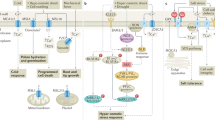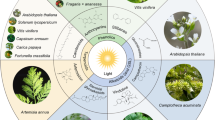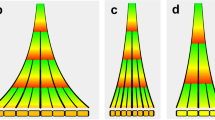Abstract
The plant hormones are a structurally unrelated collection of small molecules derived from various essential metabolic pathways. These compounds are important regulators of plant growth and mediate responses to both biotic and abiotic stresses. During the last ten years there have been many exciting advances in our understanding of plant hormone biology, including new discoveries in the areas of hormone biosynthesis, transport, perception and response. Receptors for many of the major hormones have now been identified, providing new opportunities to study the chemical specificity of hormone signaling. These studies also reveal a surprisingly important role for the ubiquitin-proteasome pathway in hormone signaling. In addition, recent work confirms that hormone signaling interacts at multiple levels during plant growth and development. In the future, a major challenge will be to understand how the information conveyed by these simple compounds is integrated during plant growth.
This is a preview of subscription content, access via your institution
Access options
Subscribe to this journal
Receive 12 print issues and online access
$259.00 per year
only $21.58 per issue
Buy this article
- Purchase on Springer Link
- Instant access to full article PDF
Prices may be subject to local taxes which are calculated during checkout




Similar content being viewed by others
References
Sachs, J. Stoff und Form der Pflanzenorgane. Arb. Bot. Inst. Würzburg 2, 452–488 (1880).
Darwin, C. The Power of Movement in Plants (John Murray, London, 1880).
Jun, J.H., Fiume, E. & Fletcher, J.C. The CLE family of plant polypeptide signaling molecules. Cell. Mol. Life Sci. 65, 743–755 (2008).
Davies, P.J. in Plant Hormones Physiology, Biochemistry and Molecular Biology (ed. Davies, P.J.) 1–12 (Kluwer Academic Publishers, Dordrecht, The Netherlands, 1995).
Strader, L.C. & Bartel, B. A new path to auxin. Nat. Chem. Biol. 4, 337–339 (2008).
Woodward, A.W. & Bartel, B. Auxin: regulation, action, and interaction. Ann. Bot. (Lond.) 95, 707–735 (2005).
Vieten, A., Sauer, M., Brewer, P.B. & Friml, J. Molecular and cellular aspects of auxin-transport-mediated development. Trends Plant Sci. 12, 160–168 (2007).
Badescu, G.O. & Napier, R.M. Receptors for auxin: will it all end in TIRs? Trends Plant Sci. 11, 217–223 (2006).
Guilfoyle, T.J. & Hagen, G. Auxin response factors. Curr. Opin. Plant Biol. 10, 453–460 (2007).
Szemenyei, H., Hannon, M. & Long, J.A. TOPLESS mediates auxin-dependent transcriptional repression during Arabidopsis embryogenesis. Science 319, 1384–1386 (2008).
Mockaitis, K. & Estelle, M. Auxin receptors and plant development: a new signaling paradigm. Annu. Rev. Cell Dev. Biol. 24, 55–80 (2008).
Pickart, C.M. Mechanisms underlying ubiquitination. Annu. Rev. Biochem. 70, 503–533 (2001).
Deshaies, R.J. SCF and Cullin/Ring H2-based ubiquitin ligases. Annu. Rev. Cell Dev. Biol. 15, 435–467 (1999).
Gagne, J.M., Downes, B.P., Shiu, S.H. Durshi, A.M. & Vierstra, R.D. The F-box subunit of the SCF E3 complex is encoded by a diverse superfamily of genes in Arabidopsis. Proc. Natl. Acad. Sci. USA 99, 11519–11524 (2002).
Lechner, E., Achard, P., Vansiri, A., Potuschak, T. & Genschik, P. F-box proteins everywhere. Curr. Opin. Plant Biol. 9, 631–638 (2006).
Ruegger, M. et al. The TIR1 protein of Arabidopsis functions in auxin response and is related to human SKP2 and yeast grr1p. Genes Dev. 12, 198–207 (1998).
Gray, W.M., Kepinski, S., Rouse, D., Leyser, O. & Estelle, M. Auxin regulates SCFTIR1-dependent degradation of AUX/IAA proteins. Nature 414, 271–276 (2001).
Dharmasiri, N., Dharmasiri, S., Jones, A.M. & Estelle, M. Auxin action in a cell-free system. Curr. Biol. 13, 1418–1422 (2003).
Kepinski, S. & Leyser, O. Auxin-induced SCFTIR1-Aux/IAA interaction involves stable modification of the SCFTIR1 complex. Proc. Natl. Acad. Sci. USA 101, 12381–12386 (2004).
Tan, X. et al. Mechanism of auxin perception by the TIR1 ubiquitin ligase. Nature 446, 640–645 (2007).
Nemhauser, J.L., Mockler, T.C. & Chory, J. Interdependency of brassinosteroid and auxin signaling in Arabidopsis. PLoS Biol. 2, E258 (2004).
Peng, Z.Y. et al. Arabidopsis Hormone Database: a comprehensive genetic and phenotypic information database for plant hormone research in Arabidopsis. Nucleic Acids Res. 37, D975–D982 (2009).
Wasternack, C. Jasmonates: an update on biosynthesis, signal transduction and action in plant stress response, growth and development. Ann. Bot. (Lond.) 100, 681–697 (2007).
Xie, D.X., Feys, B.F., James, S., Nieto-Rostro, M. & Turner, J.G. COI1: an Arabidopsis gene required for jasmonate-regulated defense and fertility. Science 280, 1091–1094 (1998).
Thines, B. et al. JAZ repressor proteins are targets of the SCF(COI1) complex during jasmonate signalling. Nature 448, 661–665 (2007).
Chini, A. et al. The JAZ family of repressors is the missing link in jasmonate signalling. Nature 448, 666–671 (2007).
Melotto, M. et al. A critical role of two positively charged amino acids in the Jas motif of Arabidopsis JAZ proteins in mediating coronatine- and jasmonoyl isoleucine-dependent interactions with the COI1 F-box protein. Plant J. 55, 979–988 (2008).
Katsir, L., Schilmiller, A.L., Staswick, P.E., He, S.Y. & Howe, G.A. COI1 is a critical component of a receptor for jasmonate and the bacterial virulence factor coronatine. Proc. Natl. Acad. Sci. USA 105, 7100–7105 (2008).
Yamaguchi, S. Gibberellin metabolism and its regulation. Annu. Rev. Plant Biol. 59, 225–251 (2008).
Peng, J. et al. 'Green revolution' genes encode mutant gibberellin response modulators. Nature 400, 256–261 (1999).
Fleet, C.M. & Sun, T.P.A. DELLAcate balance: the role of gibberellin in plant morphogenesis. Curr. Opin. Plant Biol. 8, 77–85 (2005).
Schwechheimer, C. Understanding gibberellic acid signaling–are we there yet? Curr. Opin. Plant Biol. 11, 9–15 (2008).
Itoh, H., Matsuoka, M. & Steber, C.M. A role for the ubiquitin-26S-proteasome pathway in gibberellin signaling. Trends Plant Sci. 8, 492–497 (2003).
McGinnis, K.M. et al. The Arabidopsis SLEEPY1 gene encodes a putative F-box subunit of an SCF E3 ubiquitin ligase. Plant Cell 15, 1120–1130 (2003).
Sasaki, A. et al. Accumulation of phosphorylated repressor for gibberellin signaling in an F-box mutant. Science 299, 1896–1898 (2003).
Feng, S. et al. Coordinated regulation of Arabidopsis thaliana development by light and gibberellins. Nature 451, 475–479 (2008).
de Lucas, M. et al. A molecular framework for light and gibberellin control of cell elongation. Nature 451, 480–484 (2008).
Ueguchi-Tanaka, M. et al. GIBBERELLIN INSENSITIVE DWARF1 encodes a soluble receptor for gibberellin. Nature 437, 693–698 (2005).
Griffiths, J. et al. Genetic characterization and functional analysis of the GID1 gibberellin receptors in Arabidopsis. Plant Cell 18, 3399–3414 (2006).
Nakajima, M. et al. Identification and characterization of Arabidopsis gibberellin receptors. Plant J. 46, 880–889 (2006).
Willige, B.C. et al. The DELLA domain of GA INSENSITIVE mediates the interaction with the GA INSENSITIVE DWARF1A gibberellin receptor of Arabidopsis. Plant Cell 19, 1209–1220 (2007).
Shimada, A. et al. Structural basis for gibberellin recognition by its receptor GID1. Nature 456, 520–523 (2008).
Murase, K., Hirano, Y., Sun, T.P. & Hakoshima, T. Gibberellin-induced DELLA recognition by the gibberellin receptor GID1. Nature 456, 459–463 (2008).
Miller, C., Skoog, F., Saltza, M.V. & Strong, M. Kinetic, a cell division factor from deoxyribonucleic acid. J. Am. Chem. Soc. 77, 1392 (1955).
To, J.P. & Kieber, J.J. Cytokinin signaling: two-components and more. Trends Plant Sci. 13, 85–92 (2008).
Murray, J.D. et al. A cytokinin perception mutant colonized by Rhizobium in the absence of nodule organogenesis. Science 315, 101–104 (2007).
Frugier, F., Kosuta, S., Murray, J.D., Crespi, M. & Szczyglowski, K. Cytokinin: secret agent of symbiosis. Trends Plant Sci. 13, 115–120 (2008).
Sakakibara, H. Cytokinins: activity, biosynthesis, and translocation. Annu. Rev. Plant Biol. 57, 431–449 (2006).
Kurakawa, T. et al. Direct control of shoot meristem activity by a cytokinin-activating enzyme. Nature 445, 652–655 (2007).
Rashotte, A.M., Carson, S.D., To, J.P. & Kieber, J.J. Expression profiling of cytokinin action in Arabidopsis. Plant Physiol. 132, 1998–2011 (2003).
Rashotte, A.M. et al. A subset of Arabidopsis AP2 transcription factors mediates cytokinin responses in concert with a two-component pathway. Proc. Natl. Acad. Sci. USA 103, 11081–11085 (2006).
Theologis, A. One rotten apple spoils the whole bushel: the role of ethylene in fruit ripening. Cell 70, 181–184 (1992).
Kendrick, M.D. & Chang, C. Ethylene signaling: new levels of complexity and regulation. Curr. Opin. Plant Biol. 11, 479–485 (2008).
De Paepe, A. & Van der Straeten, D. Ethylene biosynthesis and signaling: an overview. Vitam. Horm. 72, 399–430 (2005).
Adams, D.O. & Yang, S.F. Ethylene biosynthesis: identification of 1-aminocyclopropane-1-carboxylic acid as an intermediate in the conversion of methionine to ethylene. Proc. Natl. Acad. Sci. USA 76, 170–174 (1979).
Wang, K.L., Yoshida, H., Lurin, C. & Ecker, J.R. Regulation of ethylene gas biosynthesis by the Arabidopsis ETO1 protein. Nature 428, 945–950 (2004).
Christians, M.J. et al. The BTB ubiquitin ligases ETO1, EOL1 and EOL2 act collectively to regulate ethylene biosynthesis in Arabidopsis by controlling type-2 ACC synthase levels. Plant J. 57, 332–345 (2009).
Qiao, H., Chang, K.N., Yazaki, J. & Ecker, J.R. Interplay between ethylene, ETP1/ETP2 F-box proteins, and degradation of EIN2 triggers ethylene responses in Arabidopsis. Genes Dev. 23, 512–521 (2009).
Nambara, E. & Marion-Poll, A. Abscisic acid biosynthesis and catabolism. Annu. Rev. Plant Biol. 56, 165–185 (2005).
Israelsson, M. et al. Guard cell ABA and CO2 signaling network updates and Ca2+ sensor priming hypothesis. Curr. Opin. Plant Biol. 9, 654–663 (2006).
Shen, Y.Y. et al. The Mg-chelatase H subunit is an abscisic acid receptor. Nature 443, 823–826 (2006).
Muller, A.H. & Hansson, M. The barley magnesium chelatase 150-kDa subunit is not an abscisic acid receptor. Plant Physiol. published online, doi:10.1104/pp.109.135277 (28 January 2009).
Liu, X. et al. A G protein-coupled receptor is a plasma membrane receptor for the plant hormone abscisic acid. Science 315, 1712–1716 (2007).
Johnston, C.A. et al. Comment on “A G protein coupled receptor is a plasma membrane receptor for the plant hormone abscisic acid”. Science 318, 914, author reply 914 (2007).
Guo, J., Zeng, Q., Emami, M., Ellis, B.E. & Chen, J.G. The GCR2 gene family is not required for ABA control of seed germination and early seedling development in Arabidopsis. PLoS One 3, e2982 (2008).
Gao, Y. et al. Genetic characterization reveals no role for the reported ABA receptor, GCR2, in ABA control of seed germination and early seedling development in Arabidopsis. Plant J. 52, 1001–1013 (2007).
Pandey, S., Nelson, D.C. & Assmann, S.M. Two novel GPCR-type G proteins are abscisic acid receptors in Arabidopsis. Cell 136, 136–148 (2009).
McCourt, P. & Creelman, R. The ABA receptors–we report you decide. Curr. Opin. Plant Biol. 11, 474–478 (2008).
Hirayama, T. & Shinozaki, K. Perception and transduction of abscisic acid signals: keys to the function of the versatile plant hormone ABA. Trends Plant Sci. 12, 343–351 (2007).
Finkelstein, R., Reeves, W., Ariizumi, T. & Steber, C. Molecular aspects of seed dormancy. Annu. Rev. Plant Biol. 59, 387–415 (2008).
Stone, S.L., Williams, L.A., Farmer, L.M., Vierstra, R.D. & Callis, J. KEEP ON GOING, a RING E3 ligase essential for Arabidopsis growth and development, is involved in abscisic acid signaling. Plant Cell 18, 3415–3428 (2006).
Zhang, X., Garreton, V. & Chua, N.H. The AIP2 E3 ligase acts as a novel negative regulator of ABA signaling by promoting ABI3 degradation. Genes Dev. 19, 1532–1543 (2005).
Vlot, A.C., Klessig, D.F. & Park, S.W. Systemic acquired resistance: the elusive signal(s). Curr. Opin. Plant Biol. 11, 436–442 (2008).
Durrant, W.E. & Dong, X. Systemic acquired resistance. Annu. Rev. Phytopathol. 42, 185–209 (2004).
Gingerich, D.J. et al. Cullins 3a and 3b assemble with members of the broad complex/tramtrack/bric-a-brac (BTB) protein family to form essential ubiquitin-protein ligases (E3s) in Arabidopsis. J. Biol. Chem. 280, 18810–18821 (2005).
Stepanova, A.N., Hoyt, J.M., Hamilton, A.A. & Alonso, J.M. A Link between ethylene and auxin uncovered by the characterization of two root-specific ethylene-insensitive mutants in Arabidopsis. Plant Cell 17, 2230–2242 (2005).
Stepanova, A.N. et al. TAA1-mediated auxin biosynthesis is essential for hormone crosstalk and plant development. Cell 133, 177–191 (2008).
Tao, Y. et al. Rapid synthesis of auxin via a new tryptophan-dependent pathway is required for shade avoidance in plants. Cell 133, 164–176 (2008).
Tsuchisaka, A. & Theologis, A. Unique and overlapping expression patterns among the Arabidopsis 1-amino-cyclopropane-1-carboxylate synthase gene family members. Plant Physiol. 136, 2982–3000 (2004).
Feraru, E. & Friml, J. PIN polar targeting. Plant Physiol. 147, 1553–1559 (2008).
Laplaze, L. et al. Cytokinins act directly on lateral root founder cells to inhibit root initiation. Plant Cell 19, 3889–3900 (2007).
Blilou, I. et al. The PIN auxin efflux facilitator network controls growth and patterning in Arabidopsis roots. Nature 433, 39–44 (2005).
Goda, H. et al. Comprehensive comparison of auxin-regulated and brassinosteroid-regulated genes in Arabidopsis. Plant Physiol. 134, 1555–1573 (2004).
Mouchel, C.F., Osmont, K.S. & Hardtke, C.S. BRX mediates feedback between brassinosteroid levels and auxin signalling in root growth. Nature 443, 458–461 (2006).
Weiss, D. & Ori, N. Mechanisms of cross talk between gibberellin and other hormones. Plant Physiol. 144, 1240–1246 (2007).
Fu, X. & Harberd, N.P. Auxin promotes Arabidopsis root growth by modulating gibberellin response. Nature 421, 740–743 (2003).
Achard, P., Vriezen, W.H., Van Der Straeten, D. & Harberd, N.P. Ethylene regulates Arabidopsis development via the modulation of DELLA protein growth repressor function. Plant Cell 15, 2816–2825 (2003).
Leyser, O. The control of shoot branching: an example of plant information processing. Plant Cell Environ. published online, doi:10.1111/j.1365–3040.2009.01930.x (1 January 2009).
Gomez-Roldan, V. et al. Strigolactone inhibition of shoot branching. Nature 455, 189–194 (2008).
Umehara, M. et al. Inhibition of shoot branching by new terpenoid plant hormones. Nature 455, 195–200 (2008).
Bennett, T. et al. The Arabidopsis MAX pathway controls shoot branching by regulating auxin transport. Curr. Biol. 16, 553–563 (2006).
Stirnberg, P., van De Sande, K. & Leyser, H.M. MAX1 and MAX2 control shoot lateral branching in Arabidopsis. Development 129, 1131–1141 (2002).
Flores, T. et al. Arginase-negative mutants of Arabidopsis exhibit increased nitric oxide signaling in root development. Plant Physiol. 147, 1936–1946 (2008).
Hayashi, K. et al. Small-molecule agonists and antagonists of F-box protein-substrate interactions in auxin perception and signaling. Proc. Natl. Acad. Sci. USA 105, 5632–5637 (2008).
Jönsson, H., Heisler, M.G., Shapiro, B.E., Meyerowitz, E.M. & Mjolsness, E. An auxin-driven polarized transport model for phyllotaxis. Proc. Natl. Acad. Sci. USA 103, 1633–1638 (2006).
Hamant, O. et al. Developmental patterning by mechanical signals in Arabidopsis. Science 322, 1650–1655 (2008).
Grieneisen, V.A., Xu, J., Maree, A.F., Hogeweg, P. & Scheres, B. Auxin transport is sufficient to generate a maximum and gradient guiding root growth. Nature 449, 1008–1013 (2007).
Kramer, E.M., Draye, X. & Bennett, M.J. Modelling root growth and development. SEB Exp. Biol. Ser. 61, 195–211 (2008).
Smith, R.S. et al. A plausible model of phyllotaxis. Proc. Natl. Acad. Sci. USA 103, 1301–1306 (2006).
Acknowledgements
The authors' work is supported by grants to M.E. from the US National Institutes of Health (GM 43644), the US Department of Energy (De-FG02-02ER15312) and the US National Science Foundation (MCB-0519970, IOS-0849069).
Author information
Authors and Affiliations
Corresponding author
Rights and permissions
About this article
Cite this article
Santner, A., Calderon-Villalobos, L. & Estelle, M. Plant hormones are versatile chemical regulators of plant growth. Nat Chem Biol 5, 301–307 (2009). https://doi.org/10.1038/nchembio.165
Published:
Issue Date:
DOI: https://doi.org/10.1038/nchembio.165
This article is cited by
-
Bacteria from the skin of amphibians promote growth of Arabidopsis thaliana and Solanum lycopersicum by modifying hormone-related transcriptome response
Plant Molecular Biology (2024)
-
On the continuum mechanics of growing plant-like structures
Computational Mechanics (2024)
-
Strigolactones and abscisic acid interactions affect plant development and response to abiotic stresses
BMC Plant Biology (2023)
-
The determination of peanut (Arachis hypogaea L.) pod-sizes during the rapid-growth stage by phytohormones
BMC Plant Biology (2023)
-
Novel insights into the mechanism(s) of silicon-induced drought stress tolerance in lentil plants revealed by RNA sequencing analysis
BMC Plant Biology (2023)



